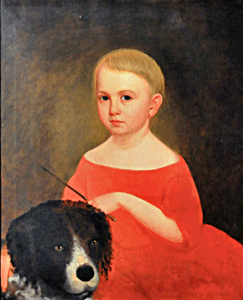| Join | Official Historian, City of Stamford | Blog | About Us | |
| Jewish Historical Society | Civil War Roundtable | Contact Us | |
|
|
|
|
The Stamford Historical Society PresentsBest Face Forward
|
 |
Oil on canvas Moses Billings (1809–1884) Museum Purchase PM64-10 R154 |
Born and raised in Erie, Pennsylvania, William came to Stamford to work for his brother, George C. Blickensderfer, inventor and founder in 1892 of the Blickensderfer Typewriter Company. The “Blick,” as it was popularly called, was a real success from the beginning, both in this country and abroad. This small portable typewriter with its innovative rotary print wheel, was introduced at the 1893 Columbian Exposition in Chicago where it created a great deal of excitement and received two awards.
William was involved in the day to day management of the company and became its treasurer. An obituary in the Stamford Advocate upon the death of his brother, George, praises William thusly: “For twenty years William J. Blickensderfer has been his brother’s other self and inseparable companion, supplying the calmer afterthought, the careful judgment, of his brother’s more impetuous genius.”
William was three years old when he posed for this endearing portrait along with his dog. Boys in the 19th century wore dresses and skirts until they became four to six years old. Graduating into breeches signified their entrance into a masculine world, leaving behind the female-focused world of early childhood.
Artist Moses Billings was born in Amherst, New Hampshire and was a self-taught artist as there were few art schools outside the major cities. Becoming an itinerant artist he traveled to cities in upstate New York, Ohio and Washington, D.C., where he painted President John Quincy Adams and Dolly Madison, neither of which sold and were taken back to Erie.
Settling in Erie, Pennsylvania by 1849 he made a living painting the prominent residents of that prospering young city. It is claimed that he painted over 500 portraits in his lifetime.
One critic has said of his work, “his lack of training in anatomy was obvious to the trained eye but his facial features, particularly the eyes, gave his likenesses excellent quality, while his colors and period apparel were realistic.”
This painting of little William is representative of American Folk Art portraits so admired by collectors today.
Image © Stamford Historical Society